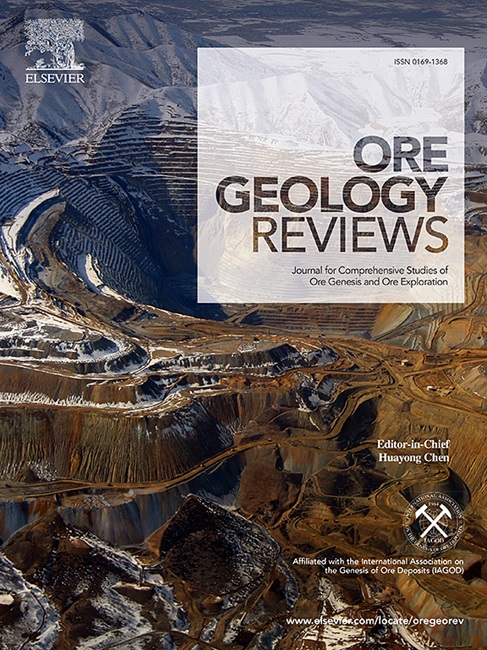Malage skarn-type Sn-polymetallic deposit in the vast Gejiu ore field: New data on its age and form
IF 3.2
2区 地球科学
Q1 GEOLOGY
引用次数: 0
Abstract
The Malage skarn-type deposit in the world’s largest Gejiu Sn-polymetallic ore field contains ore bodies and associated skarns, which typically occurring near the contact zone between the granitic intrusions and the carbonate host rock. In this study, detailed textural analyses and chemical composition data of garnet, combined with U–Pb geochronology of different garnet generations and cassiterite, have been systematically investigated to constrain the evolution of hydrothermal fluids. Three generations of garnets (Grt I, Grt II, and Grt III) are detected in the deposit based on the petrographic characteristics. The U–Pb ages for Grt I, Grt II and Grt III are 81.8 ± 1.1 Ma, 81.1 ± 1.8 and 80.4 ± 2.0 Ma, while the cassiterite show more precise U–Pb age of 80.3 ± 0.2 Ma and 80.2 ± 0.5 Ma. This chronological coherence indicates these minerals formed during the same magmatic-hydrothermal event. Magnetite and hematite inclusions-bearing Grt I exhibits a right-skewed rare earth element (REE) pattern, with light REE/heavy REE (LREE/HREE) ratios (1.04–468.74) and negative Eu anomalies (0.06–0.26). Grt II shows a similar REE pattern, with high LREE/HREE ratios (1.03–416.99) and negative Eu anomalies (0.02–0.21). Grt III exhibits a relatively flat REE distribution, lower LREE/HREE ratios (0.48–25.96) and negative Eu anomalies (0.01–0.10). From Grt I to Grt III, the fluid with high temperature, oxygen fugacity and low fluid-rock transitioned into a fluid with low-oxygen fugacity and high fluid-rock ratio, thereby cooling the magmatic fluid with low-oxygen fugacity and high water–rock ratio. Futhermore, Sn precipitation occurs due to the early high temperature and oxygen fugacity fluid, and the high Sn content (644–16,920 ppm) in garnet may be associated with magma properties.

大个旧矿田Malage矽卡岩型锡多金属矿床:时代与形态新资料
世界上最大的个旧锡多金属矿田Malage矽卡岩型矿床含矿体及伴生矽卡岩,主要产于花岗岩侵入体与碳酸盐寄主岩接触带附近。本研究通过详细的石榴石结构分析和化学成分数据,结合不同石榴石世代和锡石的U-Pb年代学,对热液流体的演化进行了系统研究。根据岩石学特征,在矿床中发现了3代石榴石(ⅰ、ⅱ、ⅲ)。Grt I、Grt II和Grt III的U-Pb年龄分别为81.8±1.1 Ma、81.1±1.8 Ma和80.4±2.0 Ma,而锡石的U-Pb年龄更为精确,分别为80.3±0.2 Ma和80.2±0.5 Ma。这种时间上的一致性表明这些矿物形成于同一岩浆热液事件。含磁铁矿和赤铁矿包裹体的Grtⅰ呈现右倾稀土元素(REE)模式,轻REE/重REE (LREE/HREE)比值为1.04 ~ 468.74,Eu负异常为0.06 ~ 0.26。Grt II表现出相似的稀土模式,LREE/HREE比值较高(1.03 ~ 416.99),Eu呈负异常(0.02 ~ 0.21)。Grt III的REE分布相对平坦,LREE/HREE比值较低(0.48 ~ 25.96),Eu负异常(0.01 ~ 0.10)。从Grt I到Grt III,高温、氧逸度、低流岩比流体转变为低氧逸度、高流岩比流体,从而冷却了低氧逸度、高水岩比的岩浆流体。Sn的析出与早期高温和氧逸性流体有关,石榴石中Sn的高含量(644 ~ 16920 ppm)可能与岩浆性质有关。
本文章由计算机程序翻译,如有差异,请以英文原文为准。
求助全文
约1分钟内获得全文
求助全文
来源期刊

Ore Geology Reviews
地学-地质学
CiteScore
6.50
自引率
27.30%
发文量
546
审稿时长
22.9 weeks
期刊介绍:
Ore Geology Reviews aims to familiarize all earth scientists with recent advances in a number of interconnected disciplines related to the study of, and search for, ore deposits. The reviews range from brief to longer contributions, but the journal preferentially publishes manuscripts that fill the niche between the commonly shorter journal articles and the comprehensive book coverages, and thus has a special appeal to many authors and readers.
 求助内容:
求助内容: 应助结果提醒方式:
应助结果提醒方式:


